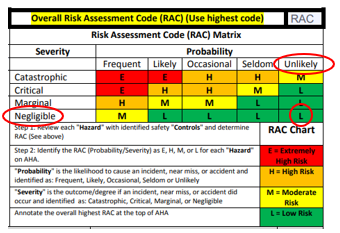Establishing Effective Controls Through Activity Hazard Analysis (AHA)

A GovGig EM 385 1-1 Compliance Article
As we have discussed previously here at GovGig, the importance of ensuring that a thorough AHA is completed as part of the project planning process is critical when working within Federal Construction. Allow us to walk you through this vital process as we identify the requirements of AHA completion and outline the steps necessary for completing this important document.
What is an AHA?
An Activity Hazard Analysis, or AHA, is a document that the US Army Corps of Engineers (USACE) uses to both document and assess hazardous work activities per scope of work. Within this document, specific hazards are identified, and controls are established to ensure that the risks of each job are minimized to their lowest acceptable level (residual risk). This is accomplished by assessing each task for appropriate hazards and assigning the risk a Risk Assessment Code (RAC) which identifies both the probability of occurrence with injury severity. When done appropriately, this risk assessment process can be effective in managing workplace risk through identification, control, and communication.
The requirements for AHA completion in part are outlined under EM 385 1-1 which states the following:
01.A.12(a)(1) The Contractor shall identify each major phase of work that will be performed on this contract. Within each major phase, all activities, tasks or Definable Features of Work (DFOWs) shall be identified that will require an Activity Hazard Analysis (AHA).
01.A.14(b) Before beginning each work activity, task or DFOW, the Contractor performing that work activity shall prepare the initial AHA. A Risk Assessment Code (RAC) is assigned to each step, to the risk that remains after controls have been applied (residual risk).
While a JSA/JHA or other similar management tool is considered equivalent to this requirement, it is recommended that the AHA process be understood and closely followed to ensure thorough compliance with this standard.
It is important to understand that the AHA process is not intended solely as a pre-planning document that sits on the shelf following government contract approval but is “intended to be developed and used by the field crews/workers performing the work, with the assistance of others (SSHO, QC, Superintendent, etc.) as needed. The initial, accepted AHA shall be provided to and used by the field crews/workers that are performing that activity. AHAs are to be considered living documents and are intended to be created in the field and updated by the workers as needed.” (01.A.14(D))
Should changes be made to the AHA which increase the RAC, the AHA must be resubmitted for acceptance.
How do you complete an AHA?
The key to completing an effective AHA lies in breaking down the task into specific steps. The steps for completing this important document are as follows:
- Work steps must be defined. Make specific efforts to identify high-risk, and complex work tasks.
- For each specific job step, hazards must be identified which may pose injury to workers involved in their task.
- Once hazards have been identified, controls (both safety and precautionary measures) must then be identified to protect workers from exposure to these hazards.
- For each hazard present, a RAC must be assigned after controls have been applied (residual risk). Remember, identified controls should not be generic but must be specific to the work environment in which workers are performing work.
Additional information must also be provided on the AHA including names of competent and qualified persons, specific training requirements relevant to the task, equipment to be used, and inspection criteria.
To illustrate this process, consider the following example:
Example: Workers need to access the top of a flat roof to perform repairs to the roof eave. This requires working near the edge of the roof exposing workers to a fall of > 10’. Given this brief information, the following information may be provided on the AHA relating to the fall hazard:

Understanding the Risk Assessment Code (RAC) Matrix
When assessing each individual task for relevant hazards, the risk must be assessed both for hazard severity and probability of occurrence. This process is known as the Risk Assessment Code, or RAC. Consider the following example to assist in clarifying this process.
Example: Utilizing the above-referenced work task requiring work on the roof eaves, with controls in place, the following RAC may be assigned to the fall hazard present:

Severity: Should work be performed while accessing the work area by working from the roof, a fall from the roof is likely to be catastrophic without workplace controls which may result in worker fatality. By utilizing controls such as the implementation of a scissor lift in conjunction with the lift guardrail system and personal fall restraint system, the severity can be lowered to Negligible as the hazard of a fall has effectively been removed. Keep in mind that not all workplace controls have the same effectiveness. (Installation of a personal fall arrest system while working on top of the roof for example would not prevent a worker from falling and could still result in worker injury, but not death. As such, the severity code would be higher for this type of control)
Probability: The likelihood of a fall from this level is unlikely as the fall hazard has effectively been removed. As such, an Unlikely probability code would be assigned to this task.
Utilizing the Risk Assessment Code Matrix with these two components in mind, the risk code assigned would be L= Low Risk for this task and acceptable to perform this job.
The Importance of Communication
All applicable controls must first be communicated with all engaged in the work activity by a pre-job brief. This briefing must include a Supervisor as well as the project Site Safety Health Officer (SSHO) if applicable. Please remember that controls are only as effective as their method of communication and implementation. It is essential that all controls identified within the AHA be thoroughly communicated to field personnel and that the expectations clearly lined out for the safe work of their applicable task.
At GovGig, we understand the complexity of Federal construction. Let us be your support system and guide you through this challenge with our expertise - take advantage of our assistance today!
Want to learn more? Reach out to our Marketing Manager, Julia Keys.
julia@govgig.us

